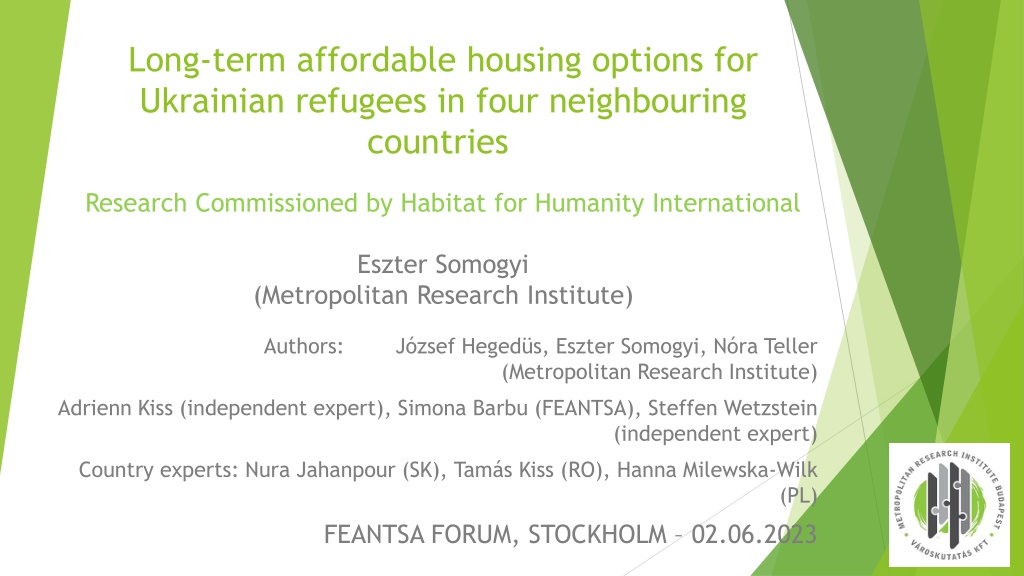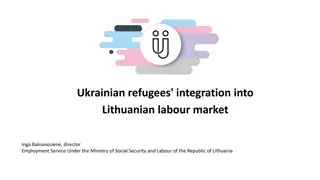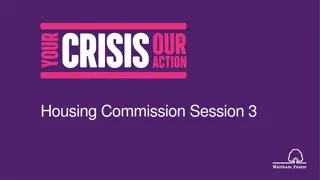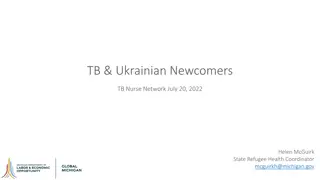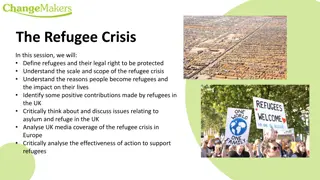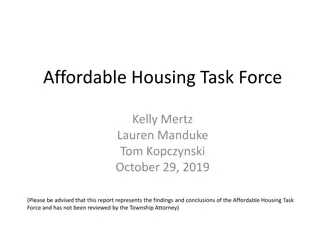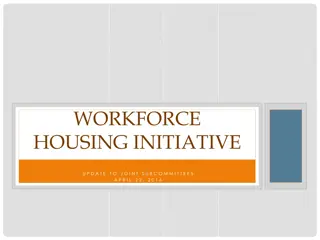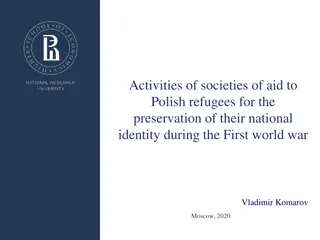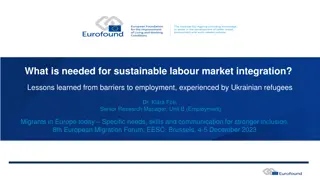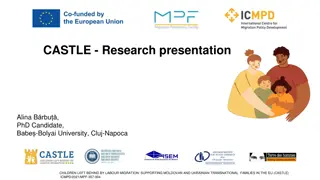Long-Term Affordable Housing Options for Ukrainian Refugees in Neighbouring Countries
This research commissioned by Habitat for Humanity International explores long-term affordable housing options for Ukrainian refugees in four neighbouring countries - Poland, Slovakia, Romania, and Hungary. It identifies common features and gaps in the housing systems, as well as strengths such as affordable rental housing programs and innovative solutions by NGOs. The report also provides insights into the number and profile of Ukrainian refugees in each country, highlighting the need for sustainable housing solutions.
Download Presentation

Please find below an Image/Link to download the presentation.
The content on the website is provided AS IS for your information and personal use only. It may not be sold, licensed, or shared on other websites without obtaining consent from the author. Download presentation by click this link. If you encounter any issues during the download, it is possible that the publisher has removed the file from their server.
E N D
Presentation Transcript
Long-term affordable housing options for Ukrainian refugees in four neighbouring countries Research Commissioned by Habitat for Humanity International Eszter Somogyi (Metropolitan Research Institute) Authors: J zsef Heged s, Eszter Somogyi, N ra Teller (Metropolitan Research Institute) Adrienn Kiss (independent expert), Simona Barbu (FEANTSA), Steffen Wetzstein (independent expert) Country experts: Nura Jahanpour (SK), Tam s Kiss (RO), Hanna Milewska-Wilk (PL) FEANTSA FORUM, STOCKHOLM 02.06.2023
Common features of the four neighbouring countries housing systems - GAPS Small social and affordable housing sector Small but increasing private rental sector: concentrated in larger cities, underregulated, grey sector Housing subsidies go to the homeownership sector (85-90% of the total housing stock) Germany: housing subsidies are tenure neutral No efficient housing allowance subsidy system that helps housing maintenance Lack of central financing to maintain and develop municipal housing discourages municipalities to maintain the sector :
Common features of the four neighbouring countries housing systems - STRENGTHS Some affordable rental housing programmes but small scale (PL, SK) More developed housing policy related institutional system in PL, SK (revolving national housing funds, national housing agencies to implement affordable rental housing programmes) Hungary: innovative solutions by NGOs and some municipalities social rental agencies Use of EU funds for housing in PL, SK: energy efficient renovation
Number and profile of UA refugees Country People who have fled Ukraine recorded in country People having fled Ukraine and registered for temporary protection or other national protection scheme 1,507,893 101,236 87,885 32,271 Border crossings from Ukraine Border crossings to Ukraine Date (2022) Poland Slovakia Romania Hungary 1,507,893 101,434 92,076 32,271 7,583,850 953,910 1,556,746 1,781,852 5,528,491 689,521 1,237,151 Data not available Not applicable 7,455,163 22 November 22 November 20 November 22 November 1,021,667 2,755,341 Not applicable 11,017,839 Germany Total 1,021,667 2,750,952 22 November 4 neighbouring countries: no experiences of providing large number of refugees HU, SK, RO transit countries, PL and DE reception countries Profile of the refugees: largely women, women with children, people with disabilities
Accommodation and housing solutions Longer-term solutions: short term solutions long term solutions ad hoc solutions Development of collective sites: separate rooms for families, shared facilities (PL) Accelerating ongoing/planned municipal rental housing investments (PL) Integration program of refugees (HU-Maltese) - 1+ year: housing + complex services (government /AMIF+UNHCR) Rent supplement schemes: UNHCR, EPIM and other organisations (HU) municipal/public housing (not in CEE countries) rental programs for the private and NGO sector emergency housing supply side subsidies for public bodies private rental sector collective sites NGOs/faith based organisations solidarity solutions
Main gaps in accommodation and housing Locational mismatch: housing availability and affordability vs. job market Municipalities There is no effective distribution system of refugees in place (small towns) Funding: government lump-sum subsidy/compensation for the providers NGOs/faith based org. Private companies Government funding HU: Private persons and NGOs are not entitled! International organisations, private donors, crowd-funding has substantial role in financing (HU!) Private individuals It is guaranteed only for short-term, periodically extended but unpredictable Decreasing interest in accommodating refugees in the private sector (both solidarity and market housing) Private rental market: price increases - competition to local demand, difficulties in administering subsidies, monitoring provision, discrimination in the market Public: municipal housing cannot be used (scarce), capacity and quality issues of collective sites
Future plans as of the beginning of 2023 Barriers to planning: no systematic data collection systems are in place on accommodation and service capacities, use of capacities, territorial distribution, funding Territorial map of distribution of refugees based on PESEL number in PL In SK online database on accommodation compensation disbursed to business and public and private individuals not user friendly In RO some data are available In HU - nothing Lack of longer-term planning by governments regarding financing and providing housing and services solutions In PL accelerating the implementation of affordable rental and municipal rental schemes Some initiatives from NGOs but governments are not responsive
III. Recommendations for long-term affordable rental housing schemes for refugees 3 models Main factors of categorisation: who receives the subsidy, who organises the concrete solution (development of project, procurement of flat etc.) in a given scheme. 3 types of actors: Landlord based models landlords, LONG-TERM RENTAL HOUSING MODELS tenants, intermediary organisations Tenant based models Intermediary based models
1. Landlord based model: increase the supply of affordable housing Landlords receive the subsidy and organise the program: pre-defined conditions Regardless the type of the landlord (private, public, non-profit): tenure neutral solutions (German model) all sectors actions are needed to meet the huge needs for affordable housing Interventions: Rapid increase mobilize the existing stock renovation of vacant dwelling, vacant non-residential buildings (offices, public buildings) short term results, esp. private rental sector Permanent, larger scale increase new construction in urban centers both municipal and private Introduction of financial measures (forms of subsidies): preferential loans and grants exact combination of the two depends on the social status of future tenants (proportion of social tenants)
2. Tenant based model to support the demand for affordable rental housing Introduce a rent supplement (housing allowance) scheme instead of current lump-sum schemes: Tenants (refugees) receive the subsidy means tested A limit on the maximum rent level for which the subsidy can be used (adjusted to local market conditions) Positive effect: whitening of the private rental market Cannot solve the problem of the lack of affordable housing in urban areas
3. Intermediary based model to overcome institutional barriers Intermediaries can ensure more effective and appropriate use of subsidies in housing schemes Involve intermediary organisations in the implementation Several roles: Administration and distribution of the subsidies Mediate between the supply and demand sides of the market by mitigating risks in the private rental and municipal sector Act as developers (public development agencies) helping the implementation of affordable housing projects Social rental agencies In Poland already legally regulated but only for municipalities Established in several cities by municipalities (Bratislava, Poznan etc.) but also several NGOs run the scheme Used in accommodating refugees (NGOs) without explicit legal framework, ad-hoc practices
Additional measures Set up an early intervention social response system: signals from multiple actors In the longer term: Improve the regulation of the private rental sector Safer solution for landlords and tenants Use EU funds on larger scale to increase affordable housing ERDF (physical intervention), ESF (rent subsidy+services), Cohesion Fund (energy efficient renovation)
Thank you for your attention! ALL REPORTS ARE AVAILABLE on: https://www.habitat.org/emea/housing-ukrainian-refugees-europe Policy brief Comparative report Country case studies
